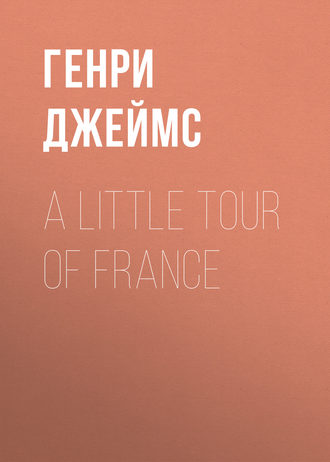
Генри Джеймс
A Little Tour of France
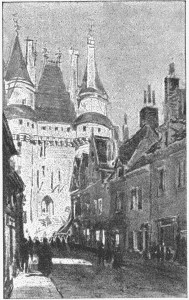
Chapter ii
Tours: the Cathedral
IT IS a very beautiful church of the second order of importance, with a charming mouse-coloured complexion and a pair of fantastic towers. There is a commodious little square in front of it, from which you may look up at its very ornamental face; but for purposes of frank admiration the sides and the rear are perhaps not sufficiently detached. The cathedral of Tours, which is dedicated to Saint Gatianus, took a long time to build. Begun in 1170, it was finished only in the first half of the sixteenth century; but the ages and the weather have interfused so well the tone of the different parts that it presents, at first at least, no striking incongruities, and looks even exceptionally harmonious and complete. There are many grander cathedrals, but there are probably few more pleasing; and this effect of delicacy and grace is at its best towards the close of a quiet afternoon, when the densely decorated towers, rising above the little Place de l'Archevêché, lift their curious lanterns into the slanting light and offer a multitudinous perch to troops of circling pigeons. The whole front, at such a time, has an appearance of great richness, although the niches which surround the three high doors (with recesses deep enough for several circles of sculpture) and indent the four great buttresses that ascend beside the huge rose-window, carry no figures beneath their little chiselled canopies. The blast of the great Revolution blew down most of the statues in France, and the wind has never set very strongly towards putting them up again. The embossed and crocketed cupolas which crown the towers of Saint Gatien are not very pure in taste; but, like a good many impurities, they have a certain character. The interior has a stately slimness with which no fault is to be found and which in the choir, rich in early glass and surrounded by a broad passage, becomes very bold and noble. Its principal treasure perhaps is the charming little tomb of the two children (who died young) of Charles VIII. and Anne of Brittany, in white marble embossed with symbolic dolphins and exquisite arabesques. The little boy and girl lie side by side on a slab of black marble, and a pair of small kneeling angels, both at their head and at their feet, watch over them. Nothing could be more elegant than this monument, which is the work of Michel Colomb, one of the earlier glories of the French Renaissance; it is really a lesson in good taste. Originally placed in the great abbey-church of Saint Martin, which was for so many ages the holy place of Tours, it happily survived the devastation to which that edifice, already sadly shattered by the wars of religion and successive profanations, finally succumbed in 1797. In 1815 the tomb found an asylum in a quiet corner of the cathedral.
I ought perhaps to be ashamed to acknowledge that I found the profane name of Balzac capable of adding an interest even to this venerable sanctuary. Those who have read the terrible little story of "Le Curé de Tours" will perhaps remember that, as I have already mentioned, the simple and childlike old Abbé Birotteau, victim of the infernal machinations of the Abbé Troubert and Mademoiselle Gamard, had his quarters in the house of that lady (she had a specialty of letting lodgings to priests), which stood on the north side of the cathedral, so close under its walls that the supporting pillar of one of the great flying buttresses was planted in the spinster's garden. If you wander round behind the church in search of this more than historic habitation you will have occasion to see that the side and rear of Saint Gatien make a delectable and curious figure. A narrow lane passes beside the high wall which conceals from sight the palace of the archbishop and beneath the flying buttresses, the far-projecting gargoyles, and the fine south porch of the church. It terminates in a little dead grass-grown square entitled the Place Grégoire de Tours. All this part of the exterior of the cathedral is very brown, ancient, Gothic, grotesque; Balzac calls the whole place "a desert of stone." A battered and gabled wing or out-house (as it appears to be) of the hidden palace, with a queer old stone pulpit jutting out from it, looks down on this melancholy spot, on the other side of which is a seminary for young priests, one of whom issues from a door in a quiet corner, and, holding it open a moment behind him, shows a glimpse of a sunny garden, where you may fancy other black young figures strolling up and down. Mademoiselle Gamard's house, where she took her two abbés to board, and basely conspired with one against the other, is still farther round the cathedral. You cannot quite put your hand upon it to-day, for the dwelling of which you say to yourself that it must have been Mademoiselle Gamard's does not fulfil all the conditions mentioned in Balzac's description. The edifice in question, however, fulfils conditions enough; in particular, its little court offers hospitality to the big buttress of the church. Another buttress, corresponding with this (the two, between them, sustain the gable of the north transept), is planted in the small cloister, of which the door on the farther side of the little soundless Rue de la Psalette, where nothing seems ever to pass, opens opposite to that of Mademoiselle Gamard. There is a very genial old sacristan, who introduced me to this cloister from the church. It is very small and solitary, and much mutilated; but it nestles with a kind of wasted friendliness beneath the big walls of the cathedral. Its lower arcades have been closed, and it has a small plot of garden in the middle, with fruit-trees which I should imagine to be too much overshadowed. In one corner is a remarkably picturesque turret, the cage of a winding staircase which ascends (no great distance) to an upper gallery, where an old priest, the chanoine-gardien of the church, was walking to and fro with his breviary. The turret, the gallery, and even the chanoine-gardien, belonged, that sweet September morning, to the class of objects that are dear to painters in water-colours.
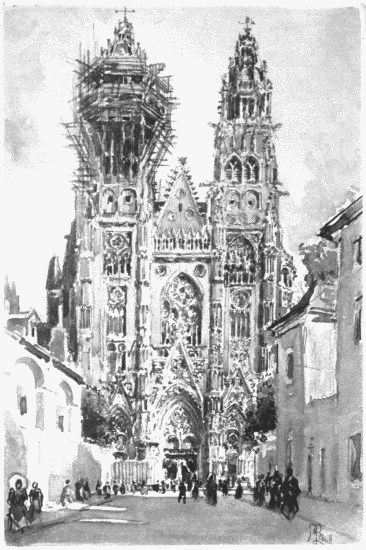
TOURS—THE CATHEDRAL
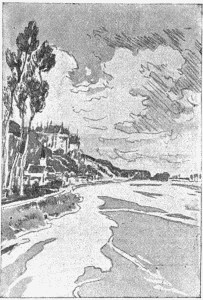
Chapter iii
Tours: Saint Martin
I HAVE mentioned the church of Saint Martin, which was for many years the sacred spot, the shrine of pilgrimage, of Tours. Originally the simple burial-place of the great apostle who in the fourth century Christianised Gaul and who, in his day a brilliant missionary and worker of miracles, is chiefly known to modern fame as the worthy that cut his cloak in two at the gate of Amiens to share it with a beggar (tradition fails to say, I believe, what he did with the other half), the abbey of Saint Martin, through the Middle Ages, waxed rich and powerful, till it was known at last as one of the most luxurious religious houses in Christendom, with kings for its titular abbots (who, like Francis I., sometimes turned and despoiled it) and a great treasure of precious things. It passed, however, through many vicissitudes. Pillaged by the Normans in the ninth century and by the Huguenots in the sixteenth, it received its death-blow from the Revolution, which must have brought to bear upon it an energy of destruction proportionate to its mighty bulk. At the end of the last century a huge group of ruins alone remained, and what we see to-day may be called the ruin of a ruin. It is difficult to understand how so vast an edifice can have been so completely obliterated. Its site is given up to several ugly streets, and a pair of tall towers, separated by a space which speaks volumes as to the size of the church and looking across the close-pressed roofs to the happier spires of the cathedral, preserve for the modern world the memory of a great fortune, a great abuse, perhaps, and at all events a great penalty. One may believe that to this day a considerable part of the foundations of the great abbey is buried in the soil of Tours. The two surviving towers, which are dissimilar in shape, are enormous; with those of the cathedral they form the great landmarks of the town. One of them bears the name of the Tour de l'Horloge; the other, the so-called Tour Charlemagne, was erected (two centuries after her death) over the tomb of Luitgarde, wife of the great Emperor, who died at Tours in 800. I do not pretend to understand in what relation these very mighty and effectually detached masses of masonry stood to each other, but in their grey elevation and loneliness they are striking and suggestive to-day; holding their hoary heads far above the modern life of the town and looking sad and conscious, as they had outlived all uses. I know not what is supposed to have become of the bones of the blessed saint during the various scenes of confusion in which they may have got mislaid; but a mystic connection with his wonder-working relics may be perceived in a strange little sanctuary on the left of the street, which opens in front of the Tour Charlemagne—whose immemorial base, by the way, inhabited like a cavern, with a diminutive doorway where, as I passed, an old woman stood cleaning a pot, and a little dark window decorated with homely flowers, would be appreciated by a painter in search of "bits." The present shrine of Saint Martin is enclosed (provisionally, I suppose) in a very modern structure of timber, where in a dusky cellar, to which you descend by a wooden staircase adorned with votive tablets and paper roses, is placed a tabernacle surrounded by twinkling tapers and prostrate worshippers. Even this crepuscular vault, however, fails, I think, to attain solemnity; for the whole place is strangely vulgar and garish. The Catholic Church, as churches go to-day, is certainly the most spectacular; but it must feel that it has a great fund of impressiveness to draw upon when it opens such sordid little shops of sanctity as this. It is impossible not to be struck with the grotesqueness of such an establishment as the last link in the chain of a great ecclesiastical tradition.
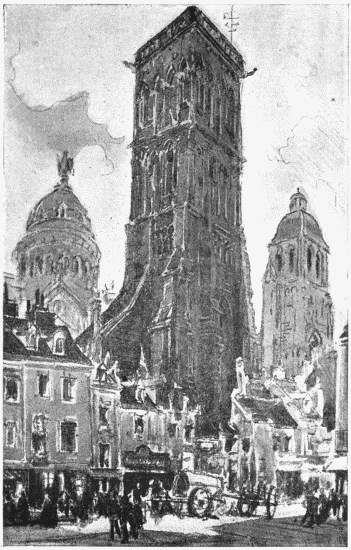
TOURS—THE TOWERS OF ST. MARTIN
In the same street, on the other side, a little below, is something better worth your visit than the shrine of Saint Martin. Knock at a high door in a white wall (there is a cross above it), and a fresh-faced sister of the convent of the Petit Saint Martin will let you into the charming little cloister, or rather fragment of cloister. Only one side of this surpassing structure remains, but the whole place is effective. In front of the beautiful arcade, which is terribly bruised and obliterated, is one of those walks of interlaced tilleuls which are so frequent in Touraine, and into which the green light filters so softly through a lattice of clipped twigs. Beyond this is a garden, and beyond the garden are the other buildings of the convent, where the placid sisters keep a school—a test, doubtless, of placidity. The imperfect arcade, which dates from the beginning of the sixteenth century (I know nothing of it but what is related in Mrs. Pattison's "Renaissance in France"), is a truly enchanting piece of work; the cornice and the angles of the arches being covered with the daintiest sculpture of arabesques, flowers, fruit, medallions, cherubs, griffins, all in the finest and most attenuated relief. It is like the chasing of a bracelet in stone. The taste, the fancy, the elegance, the refinement, are of the order that straightens up again our drooping standard of distinction. Such a piece of work is the purest flower of the French Renaissance; there is nothing more delicate in all Touraine.
There is another fine thing at Tours which is not particularly delicate, but which makes a great impression—the very interesting old church of Saint Julian, lurking in a crooked corner at the right of the Rue Royale, near the point at which this indifferent thoroughfare emerges, with its little cry of admiration, on the bank of the Loire. Saint Julian stands to-day in a kind of neglected hollow, where it is much shut in by houses; but in the year 1225, when the edifice was begun, the site was doubtless, as the architects say, more eligible. At present indeed, when once you have caught a glimpse of the stout, serious Romanesque tower—which is not high, but strong—you feel that the building has something to say and that you must stop to listen to it. Within, it has a vast and splendid nave, of immense height, the nave of a cathedral, with a shallow choir and transepts and some admirable old glass. I spent half an hour there one morning, listening to what the church had to say, in perfect solitude. Not a worshipper entered, not even an old man with a broom. I have always thought there be a sex in fine buildings; and Saint Julian, with its noble nave, is of the gender of the name of its patron.
It was that same morning, I think, that I went in search of the old houses of Tours; for the town contains several goodly specimens of the domestic architecture of the past. The dwelling to which the average Anglo-Saxon will most promptly direct his steps, and the only one I have space to mention, is the so-called Maison de Tristan l'Hermite—a gentleman whom the readers of "Quentin Durward" will not have forgotten—the hangman-in-ordinary to that great and prompt chastener Louis XI. Unfortunately the house of Tristan is not the house of Tristan at all; this illusion has been cruelly dispelled. There are no illusions left at all, in the good city of Tours, with regard to Louis XI. His terrible castle of Plessis, the picture of which sends a shiver through the youthful reader of Scott, has been reduced to suburban insignificance; and the residence of his triste compère, on the front of which a festooned rope figures as a motive for decoration, is observed to have been erected in the succeeding century. The Maison de Tristan may be visited for itself, however, if not for Sir Walter; it is an exceedingly picturesque old façade, to which you pick your way through a narrow and tortuous street—a street terminating, a little beyond it, in the walk beside the river. An elegant Gothic doorway is let into the rusty-red brickwork, and strange little beasts crouch at the angles of the windows, which are surmounted by a tall graduated gable, pierced with a small orifice, where the large surface of brick, lifted out of the shadow of the street, looks yellow and faded. The whole thing is disfigured and decayed; but it is a capital subject for a sketch in colours. Only I must wish the sketcher better luck—or a better temper—than my own. If he ring the bell to be admitted to see the court, which I believe is more sketchable still, let him have patience to wait till the bell is answered. He can do the outside while they are coming.
The Maison de Tristan, I say, may be visited for itself; but I hardly know for what the remnants of Plessis-les-Tours may be investigated. To reach them you wander through crooked suburban lanes, down the course of the Loire, to a rough, undesirable, incongruous spot, where a small, crude building of red brick is pointed out to you by your cabman (if you happen to drive) as the legendary frame of the grim portrait, and where a strong odour of pigsties and other unclean things so prostrates you for the moment that you have no energy to protest against this obvious fiction. You enter a yard encumbered with rubbish and a defiant dog, and an old woman emerges from a shabby lodge and assures you that you stand deep in historic dust. The red brick building, which looks like a small factory, rises on the ruins of the favourite residence of the dreadful Louis. It is now occupied by a company of night-scavengers, whose huge carts are drawn up in a row before it. I know not whether this be what is called the irony of fate; in any case, the effect of it is to accentuate strongly the fact (and through the most susceptible of our senses) that there is no honour for the authors of great wrongs. The dreadful Louis is reduced simply to an offence to the nostrils. The old woman shows you a few fragments—several dark, damp, much-encumbered vaults, denominated dungeons, and an old tower staircase in good condition. There are the outlines of the old moat; there is also the outline of the old guard-room, which is now a stable; and there are other silhouettes of the undistinguishable, which I have forgotten. You need all your imagination, and even then you cannot make out that Plessis was a castle of large extent, though the old woman, as your eye wanders over the neighbouring potagers, discourses much of the gardens and the park. The place looks mean and flat; and as you drive away you scarcely know whether to be glad or sorry that all those bristling horrors have been reduced to the commonplace.
A certain flatness of impression awaits you also, I think, at Marmoutier, which is the other indispensable excursion in the near neighbourhood of Tours. The remains of this famous abbey lie on the other bank of the stream, about a mile and a half from the town. You follow the edge of the big brown river; of a fine afternoon you will be glad to go farther still. The abbey has gone the way of most abbeys; but the place is a restoration as well as a ruin, inasmuch as the Sisters of the Sacred Heart have erected a terribly modern convent here. A large Gothic doorway, in a high fragment of ancient wall, admits you to a garden-like enclosure, of great extent, from which you are further introduced into an extraordinarily tidy little parlour, where two good nuns sit at work. One of these came out with me and showed me over the place—a very definite little woman, with pointed features, an intensely distinct enunciation, and those pretty manners which (for whatever other teachings it may be responsible) the Catholic Church so often instils into its functionaries. I have never seen a woman who had got her lesson better than this little trotting, murmuring, edifying nun. The interest of Marmoutier to-day is not so much an interest of vision, so to speak, as an interest of reflection—that is, if you choose to reflect (for instance) upon the wondrous legend of the seven sleepers (you may see where they lie in a row), who lived together—they were brothers and cousins—in primitive piety, in the sanctuary constructed by the blessed Saint Martin (emulous of his precursor, Saint Gatianus), in the face of the hillside that overhung the Loire, and who, twenty-five years after his death, yielded up their seven souls at the same moment and enjoyed the rare convenience of retaining in their faces, in spite of mortality, every aspect of health. The abbey of Marmoutier, which sprang from the grottos in the cliff to which Saint Gatianus and Saint Martin retired to pray, was therefore the creation of the latter worthy, as the other great abbey, in the town proper, was the monument of his repose. The cliff is still there; and a winding staircase, in the latest taste, enables you conveniently to explore its recesses. These sacred niches are scooped out of the rock, and will give you an impression if you cannot do without one. You will feel them to be sufficiently venerable when you learn that the particular pigeon-hole of Saint Gatianus, the first Christian missionary to Gaul, dates from the third century. They have been dealt with as the Catholic Church deals with most of such places to-day; polished and furbished up, labelled and ticketed—edited, with notes, in short, like an old book. The process is a mistake—the early editions had more sanctity. The modern buildings (of the Sacred Heart), on which you look down from these points of vantage, are in the vulgar taste which sets its so mechanical stamp on all new Catholic work; but there was nevertheless a great sweetness in the scene. The afternoon was lovely, and it was flushing to a close. The large garden stretched beneath us, blooming with fruit and and wine and succulent promise, and beyond it flowed the shining river. The air was still, the shadows were long, and the place, after all, was full of memories, most of which might pass for virtuous. It certainly was better than Plessis-les-Tours.






